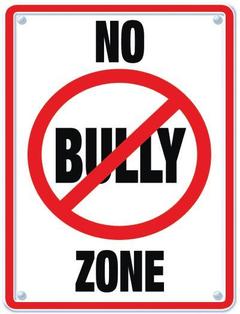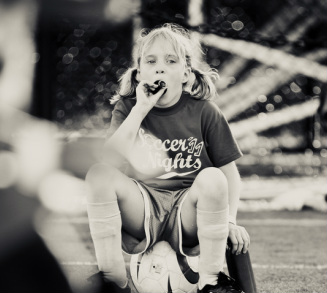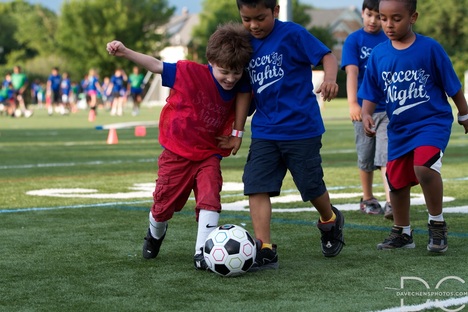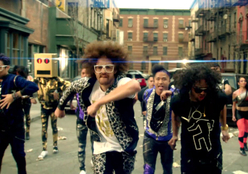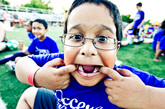Tonight's Schedule:5:30: Registration, coaches warm up with kids 6:15PM: Large Group welcome – curriculum intro 6:30PM: Division Leaders divide kids into teams 6:40 PM: Team name – establish team guidelines/expectations based on RRT 6:50 PM: Warm-ups & games in Division, skills demonstration (Skill: Passing!) 7:05 PM: Team Drill Work/play 7:35PM: Small Group Curriculum (Theme: Names!) 7:50PM: Scrimmage 8:15PM: Camp Conclusion. Present “Gold Medalists of the Night.” Teach Dance. 8:25PM: Snack dismissal 8:30PM: Check out 8:45PM: Debriefing in Divisions 9:00PM: Final Group Announcements Tonight's Ways to “Go for the Gold” for Team Medals Values Curriculum: Let’s learn each other’s Names! 1. Kids add name ‘medals’ to division ring – team earns one medal if everyone adds a medal to the ring. 2. Coaches may award their team one extra medal if players demonstrate excellent implementation of night's theme (e.g using each other's names during scrimmage). Soccer Curriculum: Passing 1. Coaches may award team one medal for participating (as a whole team) in tonight's drill work and implementing passing with accuracy, pace, and timing in team scrimmage. Coaches -- report your team's medal count to your division leaders. Tonight's Skill: PassingSee Also Pages 8, 9 and 26 of Soccer Curriculum Packet. Ways to “go for the gold” 1) Accuracy 2) Pace 3) Timing Push Pass: Coaching Points
http://www.youtube.com/playlist?list=PLDD9DF02717D5214F&feature=plcp http://www.youtube.com/watch?v=yOXrf0TIphg http://www.youtube.com/watch?v=yOXrf0TIphg&feature=relmfu 1) Accuracy (set up a 10x10 grid)
2) Pace (set up a 10x10 or 10x15 grid)
PASSING GAMES
Tonight's Value: Names!Today's Goals:
Today's Connection to Go for the Gold: Learning each other's names is part of going for the gold because the way we can be better friends, better teammates, better members of our families, better neighbors all starts with knowing the people around us. When we know each other and begin to understand each other, everything is so much better and more fun than when we are just on our own. 1. Introduce Today's Theme: Names! This week we are going to learn several ways that we can GO FOR THE GOLD together as a team. The first way we do that is to learn each other’s names. Who can tell me one reason names are important? why do people and things have names? - names set things apart from other things. - names define who we are, they tell other people who we are - names can say things about us or give us goals to live up to (ex. if you are named after your grandfather whose name means ‘strong,’ you might want to try to be very strong, or to be like your grandfather in other ways.) - names can tell us about where people are from (ex. some names are common to certain parts of the world - the name Seamus comes from Ireland, the name Helima has Arabic origin, and it means gentle, mild-mannered, and generous.) Part of going for the gold includes learning each other's names because the way we can be good friends, good neighbors, good members of our families, good teammates, all starts with knowing the people around us. When we know each other and begin to understand each other, everything is so much better than when we are just on our own. If Coach _________ is dribbling down the field and sees his teammate across the field, wide open, but doesn't know her name, he can't very well pass her the ball can he? Or if __________ is at school and needs help with an assignment, she can't ask for that help or help someone else if she doesn't know her classmates. Learning names is something easy and yet SO important! Let's start by playing a fun game that will help us do this: 2. Today's Game Younger Divisions Have kids and coaces sit in a circle by team. (important that teams are separate, this will be too crazy if done with whole division together.) This is a call and response activity, so you’ll want to start by setting a beat (clapping or hands on knees). Coach/volunteer starts: "My name is Kaiti and I like goats.” Everyone echoes this: "Your name is Kaiti and you like goats." Next person (to right or left of person who starts): "My name is Brian and I like soccer" Everyone: "Your name is Brian and you like soccer" If the 2nd-3rd graders seem on top of this, you can add in rules like “we all have to stay on the beat or we start over!” With the 1st graders, focus on the whole team being engaged and participating. Older Divisions - Hand Shake Game Team stands in a circle and the Curriculum Coach begins the game by going across the circle to a player, looking him in the eye and, shaking his hand, says, “Hello, I'm Coach Suzie.” The player then says “Hello, Coach Suzie, I'm Johnny.” Coach Suzie then takes Johnny's spot and Johnny crosses the circle and introduces himself to another teammate in the same way. This goes on until everyone has crossed the circle and the last person introduces herself to Coach Suzie, starting it back over. Then repeat the cycle, making the kids stay in the same order and this time go faster. Suzie will go to Johnny, Johnny to Megan, Megan, to Amir, Amir to Helima, Halima back to Coach Suzie. (Keep in mind each time they have to say the names, look the other person in the eye, and run to their spot). Go through the cycle a few times until they are running to get through it. Then pause the game and say, “OK, team I want you now to raise your right hand in the air.” Wait till everyone does so. “Ok, now I want you to take your right hand and point it at the person who you ran across to meet.” (wait till they do that) “Ok, keeping your right hand out, I want you to take your left hand and point to the person who ran to meet you.” “Ok, I want everyone to look in front of you at our team, and answer me, if you were a bird flying above this what would it look like? A spider web, a net? Well let's see if we can form one.” Walk forward slowly, with hands still out, until each player has grabbed hands with the two people they were introduced to. Tell your team to get ready and then start to lean slowly backwards, until there is slight tension on their grasps. After a moment or two of leaning back, bring them back to a regular stance. “Wasn't that cool? We were holding each other up as a team. The ties we made even just by meeting each other and learning each other's names can be powerful and strong. We don't learn each other's names just to do so, but because to start relationships and community with others is to go from being as strong as just one person, to as strong as many. And we'll learn over the next several days that each and every person on our team is important to the team. Just like if someone let go when we were all leaning backward, what would happen? That's right, we'd all fall to the ground!” On the count of 3, I want everyone to shout as loudly as they can the two names of the people on our team who they met tonight! 2. Today's Ring Activity Younger Divisions Pass out tonight's gold medals. Kids will write: My name is ______________ I was named by _________________ My name means ______________________ If there is time and kids want to ask their parents for the answers to the 2nd two fill-ins, let them go ask them. If not, tell them they can earn an extra medal for their team if they go home and ask and bring back the answer tomorrow. Older Divisions Kids should be in pairs. Pass out tonight's gold medals . They will have a space for: My friend's name is ______________ His name means ______________________. If there is time and kids want to ask parents for the answers to the 2nd two fill-ins, let them go ask them. If not, tell them they can earn an extra medal for their team if they go home and ask and bring back the answer tomorrow. Curriculum Team should collect medals and glue them to division ring.
0 Comments
Get excited! It's going to be great! Bullying Definitions*
Major Bullying OffensesExamples of major instances of bullying could include:
Specific Follow-Up Steps for Bullying & Physical FightingSpecific follow-up steps for bullying and physical fighting
Ultimately, it will be up to the discretion of the volunteer and staff to determine the severity of bullying. If a volunteer or staff is unsure, they should consult other staff and volunteers present.
Please note
[*] Cambridge Public Schools Anti-Bullying Policy document Consequences for Not Meeting ExpectationsStep 1 (1st offense) ·
Step 2 (2nd offense) ·
Step 3 (3rd offense)
Step 4 (4th offense)
Automatic 4th Offenses1. Physical violence 2. Any type of major bullying **For these situations it is not a guarantee that child will be permitted back into the program Follow-Up Steps to 4th Offense BehaviorsProcedures when a 4th offense behavior occurs
What happens the next day? Except in cases of physical violence or bullying (please see Bullying Definitions below), a new day means a clean slate! We encourage you to follow up with the child at the start of the evening. Encourage him/her to display positive behavior on this new evening Example: “Hey! I know you had a rough day yesterday. How are you doing today?” behavior-management-boo-to-bullying.html Vineyard Community Offerings aims to provide programs and events that are safe and fun for people of all backgrounds and cultures. To foster this environment, we have adopted the following policies and procedures regarding behavior expectations. Program wide expectations to which all participants are held:
General Tips for Managing your Team
 We're super excited about today's Volunteer Training. We think/hope it is going to be fun. In fact, Steph keeps insisting we call it a party. We hope you have a good time, meet lots of new people, and learn more about how awesome Soccer Nights is. We're delighted you came, and please do visit the blog frequently as it will have lots of useful information (much more useful than this, we promise) pertaining to each night of Soccer Nights. |
Hello from Soccer NightsHey there, we're the Soccer Nights team. This is the place to be in the know about all-things-Soccer-Nights. Archives
July 2015
Categories
All
|
